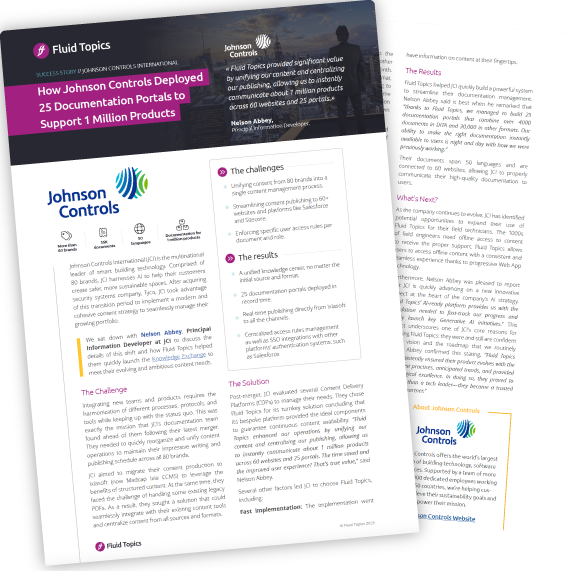
A Guide to Product Knowledge
When captured and optimized, product knowledge has many benefits: higher productivity, increased sales, better customer support, and improved product visibility and adoption. Learn about product knowledge, including the different types, their advantages, challenges, and how to improve them.

Table of Contents
- What is Product Knowledge?
- Why is Product Knowledge Important?
- Types of Product Knowledge
- Market Knowledge
- Technical Knowledge
- Functional Knowledge
- Practical, Hands-on Knowledge
- Product Knowledge Benefits
- Empower Employees
- Enhance Customer Support Efficiency
- Increase the Number of Sales
- Boost Product Adoption
- Increase Product Visibility
- Differentiate from Competitors
- Common Product Knowledge Challenges
- Keeping Up with Updates
- Siloed Knowledge
- Too Much Information
- How to Gain Product Knowledge
- Upgrade Onboarding and Training
- Engage in SME Discussions to Capture Tacit Knowledge
- Build a Product Knowledge Base
- Provide Product Demos and Webinars
- Use Customer Feedback
- Conclusion
It’s a fact that 28% of employees spend around three to four hours looking for mission-critical information every day. Another 69% lack confidence in the relevance and accuracy of their information.
When captured and organized correctly, product knowledge has wide-reaching benefits including higher productivity, increased sales, better customer support, and improved product visibility and adoption. Read on to get an in-depth overview of everything you need to know about product knowledge from why it’s important to what kinds of knowledge it includes, its benefits, potential challenges, and tips to improve product knowledge.
What is Product Knowledge?
Product knowledge refers to the understanding that an individual has about a product. This includes the product’s specifications, features, uses, benefits, and support information. Product knowledge enables someone to explain what the product does, how it works, and why it delivers value from a user or technical standpoint. The information may come in the form of traditional documentation or experience-based know-how. People apply this information when looking to sell, use, fix, or otherwise interact with those products.
Why is Product Knowledge Important?
Product knowledge enables teams across divisions to work more efficiently. Understanding products and having access to relevant, accurate product information increases the confidence of employees, so they can respond to customer needs quickly and seamlessly. Deep product knowledge is critical for several roles as it establishes credibility and builds user trust.
Take the sales team for example. Product knowledge gives them the arguments and differentiation points with competitor products that they need to answer questions and close deals with prospective customers.
Alternatively, look at the customer support team. These agents need to be able to quickly and accurately respond to any user’s needs. Product knowledge helps them provide a seamless, effective user experience, leading to customer loyalty and satisfaction.
Types of Product Knowledge
There are four core categories of product knowledge to consider when looking to manage this information. We break down each category below.
Market Knowledge
First up is market knowledge which includes reports, presentations, and comparison charts highlighting market trends, pricing models across companies, and information about competitors’ products. It also includes research on industry verticals to determine market opportunities. This is essential as various teams must understand their product’s competitive advantage for different use cases. Then, to refine their approach with customers and best respond to questions comparing different products, teams must detail buyer personas and their customer needs.
Sales teams can take this to the next level by acquiring knowledge comparing the cost and ROI of investing in their product versus competitors’ products. Customers want to know that buying a new product is worth it, and this kind of product knowledge can provide that reassurance.
Technical Knowledge
The next category is technical product knowledge. This includes any information about how a product is built, what the product specifications are, and what features the product includes.
Responding to product questions and highlighting how different functionalities will serve the needs of potential customers is particularly important to convince them to buy your product. Understanding the ins and outs of product features is necessary for sales and marketing teams looking to draw in new customers as well as customer success teams looking for upselling opportunities.
Companies should also make this information publicly available for customers doing their own research before making a purchase. They will need product guides with up-to-date information comparing different models within the company to decide.
How Does Johnson Controls Communicate About 1 Million Products Across 60 Websites?
Discover how Fluid Topics helped JCI build a powerful system to streamline documentation management.

Functional Knowledge
Functional knowledge focuses on the real-world understanding and practical skills needed to use a product for a given purpose. Knowing how to properly use a product and achieve the intended results is essential for a positive product experience. Companies typically provide this applicable information in documentation like user manuals and quick start guides.
This knowledge represents the user side of product knowledge, detailing what the user can accomplish with the product and how to do it. Beyond end users, professional service teams also need a strong functional knowledge foundation to successfully put software or hardware tools in place for clients. Additionally, it is critical that customer support teams can harness this information to help users achieve the outcomes they expect in any context.
Practical, Hands-on Knowledge
Lastly, the final category is practical, hands-on knowledge. This information goes beyond the words in manuals and guides. It is the implicit know-how learned from each installation, troubleshooting, maintenance, and support experience.
In other words, it refers to the direct understanding of a product gained through personal experience using the product. For example, in the software industry, a user may know a platform’s features from reading the set-up guide, but they can also gain a deeper understanding by using the software to solve specific problems, troubleshoot issues, and integrate it with other tools or systems.
Alternatively, field technicians can gain hands-on knowledge by operating machinery, assembling components, or performing maintenance on a product to understand its functionality and limitations.
Practical knowledge is complex to create, as user groups may have wide variations in their technical know-how. Teams should work with subject matter experts (SMEs) to capture their implicit product understanding. Companies can enhance the user experience by working to translate this implicit knowledge into personalized documentation experiences for experts and novice users.
Product Knowledge Benefits
Investing in detailed, accurate, and readily available product knowledge is essential for taking advantage of the many benefits this information brings.
Empower Employees
The longer it takes to find key information, the harder it is for employees to be productive. By making product knowledge available and promoting a deeper product understanding across teams, your employees will be able to quickly troubleshoot issues and select the right solutions to advance in their core missions without needing excessive guidance from experienced colleagues. Relevant, accurate product information allows employees to weigh the pros and cons of different actions quickly and confidently.
Enhance Customer Support Efficiency
Possessing an extensive understanding of a product’s technical specifications, features, and settings is highly important for customer support and professional services teams. Customers rely on their ability to respond quickly and accurately to any product or technical questions they may have. Access to product knowledge, easy information retrieval, and continuous product training are essential for delivering efficient customer service.
Increase the Number of Sales
Having the extra bit of product knowledge ready when a potential customer makes an objection may mean the difference between gaining new customers and losing out on revenue. Companies that arm their sales teams with extensive, up-to-date product knowledge help them effortlessly navigate sales calls to assuage any user fears or concerns. This application of product knowledge has a direct impact on the success of the company, making the ROI for businesses to invest in product knowledge clearer than ever.
Boost Product Adoption
When users have all the information they need to install, configure, and troubleshoot a product, they are more likely to continue using a product. Product knowledge is crucial for helping new users have a successful onboarding process. After all, people don’t like changing their habits, so a lack of information or difficulty onboarding will quickly lead to higher churn rates.
Increase Product Visibility
Companies don’t always think about how to use product content to drive brand visibility and product awareness. By defining which product knowledge is public, businesses can index new content to be visible to search engines, driving SEO traffic. Improving the visibility of product content in search results leads to heightened product awareness with new audiences.
Teradata's technical documentation website is now the company's most visited website with over 5 million visits in the last year alone.
Beth McFadden
Technical Project Manager for Content Operations at Teradata
Differentiate from Competitors
Product knowledge includes market research on competitors, partners, and other players related to your product’s field. By developing market knowledge, your teams have a better understanding of the key selling points that differentiate your product from competitors. It’s essential to understand this competitive advantage to improve your sales and marketing approaches.
Common Product Knowledge Challenges
To access the benefits listed above, companies must mitigate potential challenges and pitfalls.
Keeping Up with Updates
In the SaaS industry, release cycles are becoming shorter, leaving technical writers with a long backlog of content to prepare and little time to do it. Yet, their work is essential to providing a seamless, consistent user experience as products evolve. When documentation teams are unable to maintain up-to-date knowledge content, the inaccuracies result in product issues and user frustration.
Siloed Knowledge
The number of authors contributing to product knowledge continues to increase, and while diverse knowledge from across teams contributes to robust documentation, this also creates knowledge silos. Companies struggle to make scattered knowledge easily accessible to users. These fragmented systems waste user time and duplicate the work as authors are forced to recreate content that already exists in other silos.
Too Much Information
Teams need to know which facts add value to their missions and which information is less relevant. When employees or customers are overloaded with information, they grapple with identifying the core selling points, features, or value propositions of the product. This leads to confusion and missed opportunities.
When sales teams do too much market research without filtering out irrelevant details, they struggle to prioritize pitch details and arguments, resulting in lost sales. Similarly, employees may struggle with “information overwhelm” in lengthy training processes. Meanwhile, customers presented with too many options may face decision paralysis.
How to Gain Product Knowledge
There are several opportunities to deepen product knowledge, both by increasing users’ understanding of products and by capturing knowledge for future use.
Upgrade Onboarding and Training
Comprehensive training programs built with detailed videos, documents, and tests give employees a solid foundation for understanding a company’s product from their first day on the job. Furthermore, training with mentors and experts from product-focused teams helps trainees gain experiential knowledge. While onboarding typically takes place during the first weeks or months at a new job, continuous training opportunities are important for preventing knowledge gaps.
Contextual Help: 5 Ways to Provide Relevant In-Product Support
Engage in SME Discussions to Capture Tacit Knowledge
Subject matter experts have a deep level of knowledge beyond what most users possess. Capturing their implicit know-how from personal experience is difficult to formally write down. However, capturing this tacit knowledge is essential for providing a deeper, nuanced understanding of a product. From putting processes and tools in place to simply encouraging wider team collaboration with these experts, there are various ways for companies to capture and share this knowledge.
Build a Product Knowledge Base
A product knowledge base is a digital library that gathers, organizes, and delivers documentation related to the 4 types of product knowledge. This single source of truth provides a place where both internal and external users can easily access information and improve their product understanding. To facilitate this smooth flow of information, top-of-the-line product knowledge bases include key features that improve knowledge findability. This includes functionalities such as a user-friendly interface and advanced search functionalities.
Provide Product Demos and Webinars
Videos and webinars are a great opportunity to showcase precise product information, explore use cases, and walk attendees through live feature demos. By adding a question-and-answer session at the end, both internal and external users can deepen their understanding of the product, leading to better sales and user adoption rates. Recording these sessions allows teams to capture and reuse this knowledge.
Use Customer Feedback
Customer feedback provides a valuable opportunity for direct communication around documentation that users find unclear, outdated, scattered, or missing. When users can leave open-ended comments, suggestions, or questions, technical writers and product teams no longer have to guess how their users feel. As a result, they can prioritize knowledge content updates.
Conclusion
Product knowledge is more than just a nice-to-have. Whether you’re writing content, supporting users, selling solutions, or building features, a deep understanding of your product amplifies its impact.
Product knowledge isn’t something you learn once and forget. It’s a skill that continues to grow and change as your company, market, and customer needs evolve.
To seamlessly navigate these challenges, it’s essential to centralize your product knowledge in a single, accessible source of truth. That’s why we recommend using Fluid Topics, an intelligent platform designed to bring all your product content together in one place.
Schedule a free demo of Fluid Topics with a product expert
Product Knowledge FAQs
Many teams benefit from product knowledge, including sales, customer support, product teams, and leadership. Sales teams need product knowledge to swiftly and accurately answer potential customer questions while explaining what differentiates them from competitors. Customer service agents use product knowledge to provide quick responses to customer tickets. For commonly asked questions, they can also provide feedback to content teams that users need additional product documentation. Product teams need to understand the product features, roadmap, technical aspects, and the needs of customers so they can communicate a common vision to other teams. Leadership teams must understand how the product vision fits into their larger company strategy and use the product knowledge to help teams reach their goals.



